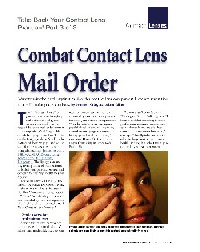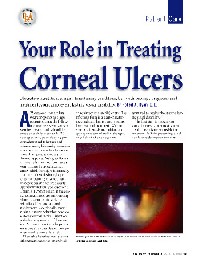In response to the article, Combat Contact Lens Mail Order, in the June issue, I would like to comment on why the mail-order contact lens retailers are thriving and will continue to flourish unless optometrists change their philosophy about prescribing contact lenses.
 |
The answer lies in the way practitioners choose to run their contact lens practice. They can either follow the business approach, or choose the professional/service approach. While both approaches can be profitable, the professional/service approach, in time, will surpass the business approach in patient care, loyalty, referrals, patient satisfaction, patient confidence, doctor and staff satisfaction and, finally, profits.
The guiding factor in selling contact lenses with the business approach is fitting a certain brand lens because of profits to be earned on the lens sale. With the encouragement of a contact lens manufacturer and vision plans, the business practitioner entices the patient (with rebate coupons or discounts) to purchase a years supply of lenses. The other important business strategy is to spend the least amount of time with and have few visits with the patient. This allows the practitioner to see more patients and, therefore, sell more lenses. However, the practitioner is likely not providing the best patient care.
With the professional/service approach, which is my preference, the guiding factors in prescribing contact lenses and maintaining continued success are based on the following: medical history; medication history; allergies; contact lens history; environmental factors, especially computer use; cornea and lid health; tear film stability; K readings; refractive status; visual requirements; follow-up care; and ongoing communication/education with the patient.
If we choose to fit lenses primarily based on sales and annuity, we are no different than the mail-order retailers. We are acting like vending machines (to quote Gary Gerber, O.D.) for the corporate world of manufacturers. With this approach, we will always be in competition with the mail-order retailers and other alternative sources.
With the professional approach, your patients receive quality eye care while your practice thrives. The majority of your patients will not even think of an alternative source for purchasing lenses.
As professionals, we have a fine balance to create: providing the best care to our patients while preserving our practice. The choice is yours.
Irwin Azman, O.D., Timonium, Md.
Loyal Patients More Profitable Than Lens Sales
In the June issue, Ms. Kirby offers optometrists seven solid ideas to aid their economic survival in the face of commercial mail-order competition. Id like to offer an amendment to one of them.
There is a segment of the buying public that will consider paying a slightly higher price when it is combined with convenience. There is, however, a segment that shops for price alone. Some of the largest of American retailers success is testimonial to the vast number of people who judge price over convenience. Besides that, one website is usually as convenient as another.
Id like to suggest an alternative. At a few dollars over the mail-order competition, the average O.D. nets less than $50 per patient per year in selling soft, disposable lenses. I would suggest meeting, or going fifty cents less than the best-known 800 retailer and here is why.
Many patients who purchase their lenses from the competition become less loyal patients and often drift to other practitioners. Emphasis on 12- to 18-month comprehensive examinations will yield far more to a practice than the $50 effort to come close to the competitions price.
Remember, the on-line competition has nothing else to sell but a product. They cant give it away, but the private O.D. can if it is
compensated by services. The brick and mortar competition doesnt seem to be able to offer comprehensive optometric services as well
as the private O.D. and therein
lays the advantage of the private practitioner.
This idea plus the other six excellent suggestions Ms. Kirby wrote about are a prescription for success.
Harvey M. Rosenwasser, O.D., F.A.A.O., Key Biscayne, Fla.
In his article, Your Role in Treating Corneal Ulcers, in the June issue, optometrist Robert Ryan says, If the presenting condition is outside of your comfort zone, immediately refer the patient to a corneal specialist.
 |
To me, the term corneal specialist means ophthalmologist. I expect this is what it also means to most optometrists.
Why not refer the patient to an optometrist colleague who is comfortable with treating the condition, rather than send the patient to a doctor outside of our profession? Unfortunately, optometry has not yet matured as a profession to the point of referring within, but people, such as Dr. Ryan, can help speed up this process by suggesting referral within the profession.
James D. Sandefur, O.D., Oakdale, La.
Dear Dr. Sandefur,
There are certainly many optometric providers across the nation who may be comfortable handling cases of infectious keratitis. In situations where the event involves risk of visual loss, one must be diligent in management to afford the patient the greatest likelihood of complete visual recovery while protecting his or her professional liability. This includes rapid intervention, logical therapeusis and appropriate use of culturing techniques to verify the offending agents sensitivity to the treatment regimen selected.
Our professional, moral and ethical responsibility is to ensure patients receive the best care for their respective maladies, and determine if that happens to be under our care or that of an optometric or ophthalmological colleague.
Robert A. Ryan, O.D., Rochester, N.Y.

